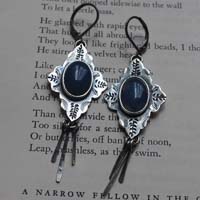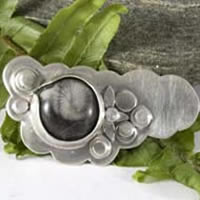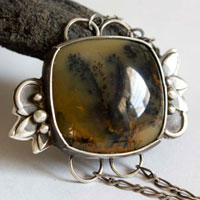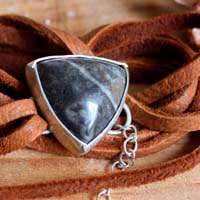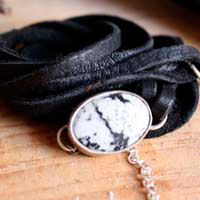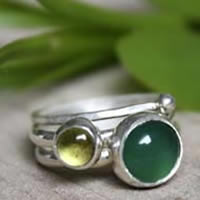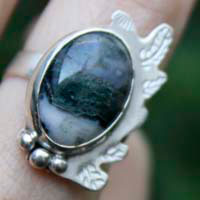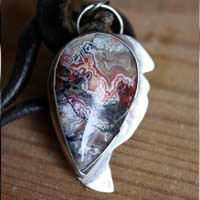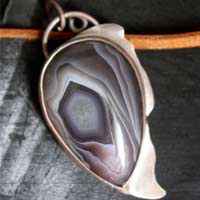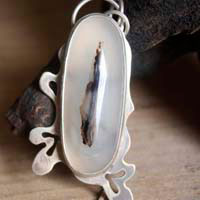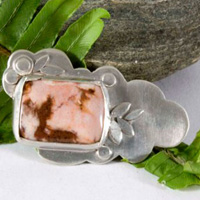- Jewelry
- Inspiration
- Good Deals
- Paintings
- About
- Contact
JEWELRY
- Anklet
- Bracelets
- Brooches
- Cufflinks
- Earrings
- Pendants & Necklaces
- Rings
- Draw your jewelry
- GOOD DEALS
- How to clean your jewel
- Metal we used
INSPIRATION
Agate: history, healing properties and lithotherapy

Agate properties

The name "agate" traces its origins to the meticulous observation of the Greek philosopher and naturalist, Theophrastus, during the 4th and 3rd centuries BCE. He cleverly bestowed this name upon the stone he identified near the "Achates" river in Sicily, now known as Dirillo. However, well before this recognition, more than 3000 years had passed since artisans were exploiting agates with various hues in this iconic region. This extensive history attests to the enduring fascination with agates and their rich legacy in gemmology.
Agate is a fascinating stone, with a geological formation that reveals remarkable complexity. It primarily forms in the cavities of volcanic rocks, where gas bubbles create empty spaces. Over time, these cavities fill with silica-rich fluids that, as they crystallize, form the characteristic concentric bands of agate. This process can take millions of years, with each layer adding a new hue or shade to the stone, depending on the minerals present in the fluid. Agate, a variety of chalcedony, is thus the result of successive deposits of these colored bands, creating a complex internal structure composed of aggregated microcrystals.
One of agate’s most remarkable features is its chromatic diversity. The inclusions of different minerals contribute to the stone’s rich palette of colors. For example, iron oxides give agate its red and brown hues, while copper can produce deep blue shades, and chlorite contributes green tones. This variety of colors is not only natural but can also be intensified through artificial treatments. Agate, being porous, readily absorbs dyes, and this color enhancement process dates back to ancient Roman times. The Romans had already mastered the art of dyeing agate, demonstrating their sophistication in gemstone treatment. This ancient knowledge allowed them to produce agates with more vibrant colors, which were then used in jewelry, ornamentation, and even for the creation of ritual objects.
The variety of agates is genuinely vast, possibly extending to thousands of different types, each with its unique characteristics. In this brief exploration, we only scratch the surface of the general properties of this stone, underscoring its immense diversity and ancient heritage that has captivated gem enthusiasts for millennia.
History, beliefs and legends about the agate
Agate, an omnipresent material throughout history, captivates with its relative abundance and a broad spectrum of shapes and colors. Its use transcends jewelry, reaching diverse fields like architecture, adorning stained glass windows, and crafting vessels, symbolizing opulence during the European Renaissance monarchy.
Beyond practical applications, agate has found a place in folklore and ancient beliefs.
In Persian tradition, magicians burned agate to ward off storms, considering it a protective charm.
In the rich tapestry of Greek mythology, agate holds symbolic significance. Linked to the Earth Mother, Gaia, it embodies strength and stability. Occasionally associated with Nyx, the goddess of night, agate suggests mystical ties to natural and cosmic forces, adding a spiritual dimension to its presence in history and culture.
Even powerful kings succumbed to the allure of this exceptional stone. The Greek ruler Mithridates of Pontus amassed an impressive collection of approximately 4000 agate vessels, underscoring the value and esteem bestowed upon this rare gem.

The Romans ascribed profound mythic significance to agate, linking it with Aurora, the goddess of dawn and mother of the winds, as well as Bona Dea, the goddess of virtue and protector of women. Cherished by the Romans, this precious stone was renowned for its medicinal virtues. They advocated agate powder mixed with water as a remedy for snake venom, showcasing their trust in its healing powers.
Agate’s influence extended far beyond Rome’s borders. In Welsh mythology, it is associated with Ceridwen, the goddess of death and fertility. Queen of the west, water, and autumn, she embodies the initiator of all magic and reigns as the sovereign of witches in Anglo-Saxon mythology.
Beyond its mythological ties, agate was revered as a protective stone, believed to ward off dangers and prevent diseases. Even insect bites and lightning were thought to be repelled by its presence, bestowing upon agate an extended aura of protection in various ancient cultures and beliefs.
In China, agate is considered a symbol of longevity, good fortune, and protection. It was believed that wearing agate or keeping it in one’s home could attract luck and foster a long and prosperous life. This stone was also used in Feng Shui practices to balance the energies of a space, bringing harmony and protection against negative influences.
In Tibet, agate, often referred to as "dzi" when carved into adorned beads, is used as a talisman to ward off evil spirits and protect the wearer. Dzi beads are particularly valued for their unique patterns and are considered sacred objects, believed to bring health, wealth, and happiness.
In Japan, agate is also esteemed for its protective qualities. It is often used in the creation of amulets intended to ward off negative energies and promote a life filled with success and serenity. Buddhist monks also used agate to craft prayer beads, believing that the stone could help purify the mind and achieve a deeper state of meditation.
Mines: it can be found everywhere in the world but more particularly in Brazil, Egypt, Germany, India, Mexico, Nepal, USA, Sicilia, Uruguay and Canada.
Healing properties and benefits of the agate
The diversity of agates translates into an impressive array of properties. While we will delve into specific varieties on this site, here are some common virtues shared by all agates:
- Traditionally, agate is reputed for alleviating thirst when placed in the mouth.
- Held in the right hand, agate is believed to bestow strength and courage upon shy individuals, becoming a talisman of confidence.
- Long employed for digestive issues and stomach ailments, agate provides soothing support for these troubles.
- Agate is renowned for amplifying the strength of other stones it’s associated with, creating a harmonious synergy.
- Its benevolent energy contributes to physical healing, making agate an ally in the recovery process from injuries.
- Placed under the pillow, agate is thought to combat insomnia and promote beautiful dreams, offering a night of restorative sleep.
- Worn as a pendant between the breasts, agate is reputed to help prevent postpartum blues and encourage breastfeeding, providing emotional support to new mothers.
- Particularly effective against dental problems, agate is sometimes used in the field of lithotherapy to promote good dental health.
 Please note that all healing properties presented for gemstones are gathered from various sources. This information is provided as a service and is not intended to treat medical conditions. It is recommended to consult a healthcare professional for serious medical issues and not to rely solely on gemstones as a treatment.
Please note that all healing properties presented for gemstones are gathered from various sources. This information is provided as a service and is not intended to treat medical conditions. It is recommended to consult a healthcare professional for serious medical issues and not to rely solely on gemstones as a treatment.
Agate jewelry samples
To learn more about litotherapy, we recommend you the following books:





